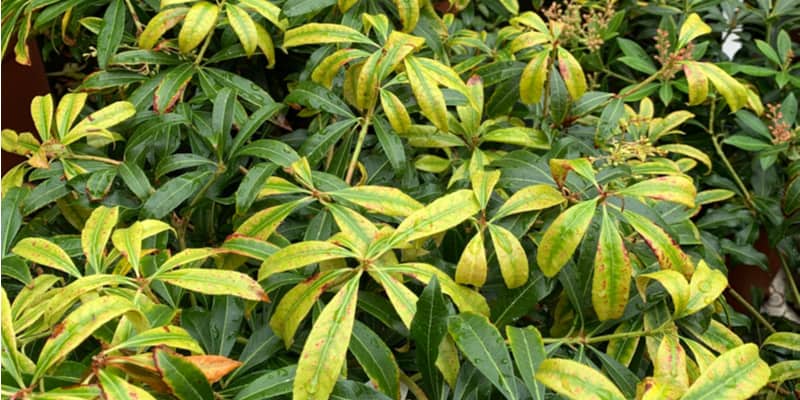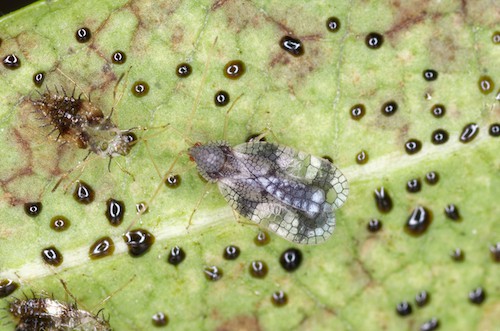
Pieris Leaf Problems
Our site is reader supported, this means we may earn a small commission from Amazon and other affiliates when you buy through links on our site.
Leaf problems with your pieris could be due to pests, disease, the environment or a lack of correct care but the two most common problems are probably fungus leaf rot also known as leaf spot disease or pieris Lacebugs.
Pests – Pieris lacebug
What is a pieris lacebug?

There’s a pest named after the pieris shrub that first appeared in Windsor, UK, in 1998. The pieris lacebug torments pieris shrubs along with rhododendrons. This is an insect that’s only about 3mm to 4mm long. Its wings have a black and white lace pattern, hence its rather attractive name. Today, about 20 species of this bug occur in Britain.
This is a sap-sucking insect. It invades your pieris plants and sucks out the sap from the leaves. The leaves become pale and develop a mottled pattern. By late summer, the leaf colour fades to a bleached-out whitish appearance. If you have a large infestation of pieris lacebugs, the leaves may completely drop off the shrub.
How to find the pieris lacebugs?
Unfortunately, these are the same symptoms as if your shrub is suffering from a lack of nutrients. To be sure it’s a lacebug infestation, look at the underside of the leaves. There you should find brown excrement spots along with cast off skins and even dead bugs.
Start looking for these insects in late spring. The eggs hatch around May and the young insects cluster on the underside of the leaves. These youthful bugs have blackish brown bodies and no wings. When they mature, some move to the upper side of the leaves, sometime around mid to late summer.
They usually die by October after laying their eggs in the veins of the leaves. But some of the adult bugs have been known to hang around until the middle of winter. So you should be checking for them all year long.
Treating the pieris lacebugs
If you have the lacebugs on only a few leaves, remove the leaves and leave the rest of the plant alone. Natural predators to the pieris lacebugs are ladybirds/ladybugs, wasps, birds and ground beetle. If you have some of these in your garden, they feed on the insects.
Next you can try an organic spray on the leaves. Look for ones with natural pyrethrum, fatty acids or plant oils. These are short-lived pesticides and have a limited negative affect on the overall environment. But you may need to reapply them if the first spraying doesn’t do the job.
Then you may need to move on to contact-action insecticides.
Warning: please don’t spray your pieris if the flowers are in bloom as it creates a danger for all pollinating insects, including bees.
Disease – Fungal Leaf Rot
Leaf problems with your pieris could also be caused by a disease, specifically Fungal Leaf Rot. I have an entire article on this that gives the background, how to identify the disease and how to treat it. Please read Pieris Forest Flame Diseases.
Location, soil and sun
Pieris shrubs like specific environmental conditions around them. These include a protected space in dappled shade and well-drained but moist acidic soil. Without this, the shrub doesn’t generate enough energy to fuel the correct development of the leaves.
I address these elements in detail in my Growing Pieris Forest Flame article. Don’t be put off by the Forest Flame variety mentioned in the title as most pieris shrubs have similar requirements.
I also have another article which covers Pieris diseases here, if you notice your Pieris is losing its leaves you can read this guide.
Care and attention
If you’re sure your pieris plant is in the right place and doesn’t have any bugs or a disease, then you may not be giving it the care and attention it needs if the leaves have problems. All you need to know about the proper care and maintenance of your pieris is in the article Growing Pieris Forest Flame. The information in this article applies to most varieties of pieris and not just to the forest flame variety.